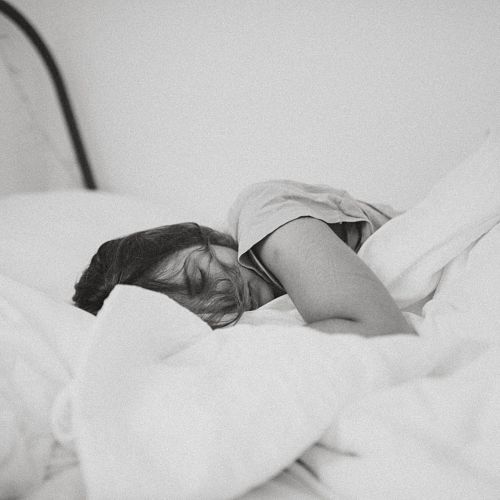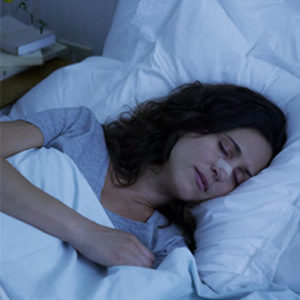Sleep apnoea is a common breathing disorder characterised by pauses in breathing or shallow breaths during sleep. The word “apnoea” comes from Greek and means “without breath.”
There are two main types of sleep apnoea:
- Obstructive sleep apnoea (OSA) – The more common form, caused by throat muscles relaxing too much during sleep. This causes the airway to narrow or close completely, interrupting normal breathing.
- Central sleep apnoea – Caused by a miscommunication between the brain and muscles that control breathing. The airway is not blocked, but the brain fails to signal the muscles to breathe.
These breathing interruptions can last 10 to 20 seconds and can occur hundreds of times throughout the night. Oxygen levels drop during these events, eventually waking the brain enough to resume normal breathing. But this sleep disruption prevents you from getting restful, uninterrupted sleep.
Recognising Symptoms
The most obvious symptom of sleep apnoea is loud snoring, sometimes accompanied by gasping or choking noises. But not everyone who snores has sleep apnea. Other common symptoms include:
- Excessive daytime sleepiness and fatigue
- Restless or interrupted sleep
- Morning headaches
- Irritability and mood changes
- Difficulty concentrating
- Frequent urination at night
People with sleep apnoea often don’t realise they have a problem. Their sleep is so disrupted that they don’t feel refreshed, but they may not fully wake up when their breathing pauses. A partner or family member noticing loud snoring is often the first clue.
Children who suffer from sleep apnoea may not have as obvious symptoms. Look out for bedwetting, behavioural disorders, poor school performance, sleepiness, not growing as they should, weight gain or unusual sleeping positions.
Health Risks of Untreated Sleep Apnoea
Leaving sleep apnea untreated can result in serious health complications, including:
High Blood Pressure – Repeated oxygen drops during sleep apnoea cause your body to produce more adrenaline and cortisol, which can cause blood pressure to rise. High blood pressure increases your risk of heart disease and stroke.
Heart Problems – With sleep apnoea, oxygen levels fall, and carbon dioxide levels rise, causing strain to the cardiovascular system. The risk of abnormal heartbeats and heart disease increases.
Stroke – Untreated sleep apnoea doubles your risk of stroke, especially in elderly people. Low oxygen levels and high blood pressure both increase stroke risk.
Type 2 Diabetes – Sleep deprivation and oxygen depletion increase insulin resistance. Studies show people with sleep apnoea are more likely to develop diabetes.
Accidents – Excessive daytime sleepiness impairs judgement, concentration and reflexes. People with untreated sleep apnoea have double the risk of having a car accident.
Who is At Risk?
Certain factors increase your risk of developing sleep apnoea:
- Age – Sleep apnoea risk increases with age. It is most common in people over 40.
- Obesity – Carrying excess weight, especially around the neck, increases risk. Fat deposits in the throat narrow the airway.
- Large Tongue/Tonsils – Enlarged tonsils or a large tongue obstruct airflow during sleep. This is a common cause in children.
- Smoking and Alcohol – Smoking causes inflammation in the airway. Alcohol relaxes muscles, increasing airway collapse.
- Nasal Obstruction – Chronic nasal congestion or a deviated septum blocks airflow.
- Gender – Men are twice as likely to have sleep apnoea due to natural throat anatomy differences.
- Family history – Having family members with sleep apnoea increases your genetic risk.
Getting Tested for Sleep Apnoea
If you suspect you may have sleep apnoea, visit your doctor. Bringing a sleep partner who has observed your sleeping can provide helpful information.
Your doctor will assess your symptoms and risk factors. They may have you complete a sleepiness questionnaire, like the Epworth Sleepiness Scale. You’ll also likely get a physical exam, including checking your blood pressure and airway.
If sleep apnoea is suspected, you’ll be referred for a sleep study. Sensors monitor your breathing, oxygen levels, heart rate, and sleep stages during sleep. After the sleep study, your doctor can diagnose sleep apnoea based on the number of breathing interruptions per hour:
- Mild – 5 to 15 breathing pauses per hour
- Moderate – 15 to 30 per hour
- Severe – Over 30 events per hour
A sleep study is the only way to definitively diagnose sleep apnoea. Home sleep tests are also available if an overnight stay isn’t possible.
Treating Sleep Apnoea
Treatment for sleep apnoea aims to prevent breathing pauses during sleep. The main treatments include:
CPAP (Continuous Positive Airway Pressure) – The most common and effective treatment, CPAP provides a constant stream of air through a mask you wear over your nose and mouth during sleep. This air pressure keeps your airway open. It can take some getting used to, but 75% of people with moderate to severe sleep apnoea benefit from CPAP.
Oral Appliances – Custom-fitted mouthpieces keep your throat and airway open during sleep by bringing your lower jaw forward. These work best for mild to moderate sleep apnoea.
Surgery – Surgery can increase the size of your airway to improve breathing during sleep. Procedures like tonsillectomy, adenoidectomy, or septoplasty may help select cases of sleep apnoea.
Lifestyle Changes – For mild sleep apnoea, losing weight, avoiding alcohol, sleeping on your side, and not smoking can lessen apnoea events. Nasal strips or sprays can also help with congestion.
Treatment relieves symptoms of sleep apnoea and lowers your risk of developing serious medical problems. Keeping up with CPAP therapy or wearing oral appliances each night is essential.
Supporting a Partner with Sleep Apnea
If your partner has been diagnosed with sleep apnea, there are several ways you can be supportive:
- Help them follow the prescribed treatment plan. Offer reminders about using their CPAP machine or oral device.
- Make healthy lifestyle changes together, like losing weight, eating well, and getting more exercise.
- Avoid drinking alcohol before bedtime as it relaxes the throat muscles.
- Help track symptoms to see if treatment is working. Note any snoring, gasping, or daytime sleepiness.
- Consider sleeping in separate beds if their snoring or CPAP machine disturbs your sleep.
- Be patient it can take time to adjust to sleep apnea treatment. Offer encouragement.
- Suggest they raise the head of the bed to reduce apnea events. Adding extra pillows can help.
- If symptoms persist with treatment, recommend they follow up with their sleep doctor to explore adjustments or alternatives.
Supporting your partner’s treatment and making healthy lifestyle changes together is crucial. But make sure to practice self-care – you need restful sleep too. Discuss any concerns openly and calmly. Working as a team helps manage sleep apnea successfully.
Sleep Apnea in Children
While sleep apnea is less common in kids, approximately 1-5% of children have obstructive sleep apnea. Some signs your child may have sleep apnea include:
- Snoring or noisy breathing during sleep
- Mouth breathing or pauses in breathing
- Restless, disturbed sleep
- Bedwetting
- Excessive daytime sleepiness
- Hyperactive behavior
Children with sleep apnea may also experience growth problems or difficulty concentrating and learning in school. Pediatric sleep apnea is often caused by enlarged tonsils and adenoids blocking the airway. Other risk factors include obesity, allergies, recurrent colds, and genetic factors.
Diagnosing sleep apnea in children involves a physical exam, sleep study, and potentially imaging tests. Removing the tonsils and adenoids through a tonsillectomy and adenoidectomy is the most common treatment. CPAP or oral devices are sometimes used for more severe cases.
As a parent, watch for signs of sleep disorders in your child. Left untreated, pediatric sleep apnea impacts development, behavior, cardiovascular health, and quality of life. Early diagnosis and treatment helps avoid long-term complications.
Take Snoring Seriously
Listening to a partner complain about your snoring can be annoying. But loud, frequent snoring could indicate sleep apnoea, especially if you never feel rested. Pay attention to other common symptoms like morning headaches, irritability, and constant drowsiness.
Don’t brush off snoring as a mere nuisance. Untreated sleep apnoea negatively impacts your sleep quality and health. Talk to your doctor about testing if you suspect you may have sleep apnoea. Diagnosis and treatment can vastly improve your sleep and wellbeing.
Conclusion
Snoring and sleep apnea should not be taken lightly. The disrupted breathing and oxygen depletion associated with sleep apnea can jeopardize your health over time. See your doctor promptly if loud snoring, chronic fatigue, or other symptoms arise. Diagnosis is straightforward through a sleep study. Various treatments like CPAP, oral appliances, and surgery can successfully manage sleep apnea in most people. With proper treatment, you can finally get the restful slumber you need.
Photo by Kinga Howard on Unsplash
Zoom Health is a leading UK supplier of Home Health Tests and Earplugs





